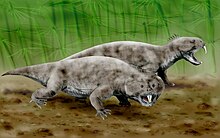Hyperodapedon
| Hyperodapedon | ||||||||||||
|---|---|---|---|---|---|---|---|---|---|---|---|---|

Skeletal reconstruction of Hyperodapedon in the Museum of Natural History at the University of Michigan . |
||||||||||||
| Temporal occurrence | ||||||||||||
| Upper Triassic ( Carnian ) | ||||||||||||
| 235 to 228 million years | ||||||||||||
| Locations | ||||||||||||
| Systematics | ||||||||||||
|
||||||||||||
| Scientific name | ||||||||||||
| Hyperodapedon | ||||||||||||
| Huxley , 1859 | ||||||||||||
| species | ||||||||||||
|
Hyperodapedon is a genus of the Rhynchosauria , a group of extinct herbivorous diapsids . It lived during the Upper Triassic ( Carnian ) and was spread almost worldwide ( cosmopolitan ); so fossils were found in South America , North America , Africa , Europe and India . Many other amniotes of the Upper Triassic were also cosmopolitan, since at that time all land masseswere unitedto form the supercontinent of Pangea . This genus wasfirst scientifically described by Thomas Huxley in 1859 with the only species Hyperodapedon gordoni .
features
Hyperodapedon was up to 2 m long. The cheek region was high and was made up mainly of the zygomatic bone and the upper jaw . The paired intermaxillary bone protruded as a tusk-like element. The lower jaw had two rows of teeth, one directly on the upper edge and the other slightly below, further inside the mouth. Viewed from above, the skull was triangular and wider than it was long, which enabled the development of large jaw muscles. The top of the oral cavity showed wide tooth plates with several rows of teeth. The temporomandibular joint prevented the jaws from moving against each other, which resulted in a very precise cutting device. Hyperodapedon had large claws on its limbs that may have been used to dig up roots.
Systematics and types
Hyperodapedon was a representative of the rhynchosaurs , which are characterized for their tusk-like outgrowths on the intermaxillary bone. Together with the very closely related genera Teyumbaita and Isalorhynchus , Hyperodapedon forms the taxon Hyperdapedontinae .
From hyperodapedon compared to other Rhynchosauriern relatively many were species described. The type species, H. gordoni , was described by Thomas Huxley in 1859 . After that 5 more species were named. The genus Scaphonyx , which was once described as a dinosaur , is now a synonym for Hyperodapedon , and the Indian species Paradapedon huxleyi , described by Lydekker in 1881 , has been listed as Hyperodapedon huxleyi since an analysis by Benton (1983) .
Kladgrgramm:
| Rhynchosauria |
|
|||||||||||||||||||||||||||||||||||||||||||||
|
|
Species cladogram:
| Hyperodapedon |
|
|||||||||||||||||||||||||||
|
|
supporting documents
- Michael J. Benton : Paleontology of the vertebrates. Translation of the 3rd English edition by Hans-Ulrich Pfretzschner. Pfeil, Munich 2007, ISBN 978-3-89937-072-0 , p. 160.
Individual evidence
- ^ A b Max C. Langer, Cesar L. Schultz: A New Species Of The Late Triassic Rhynchosaur Hyperodapedon From The Santa Maria Formation Of South Brazil. In: Palaeontology. Vol. 43, No. 6, 2000, ISSN 1475-4983 , pp. 633-652, doi : 10.1111 / 1475-4983.00143 .
- ↑ a b c Felipe Chinaglia Montefeltro, Max Cardoso Langer, Cesar Leandro Schultz: Cranial anatomy of a new genus of hyperodapedontine rhynchosaur (Diapsida, Archosauromorpha) from the Upper Triassic of southern Brazil. ( Memento of the original from January 14, 2011) Info: The archive link was inserted automatically and has not yet been checked. Please check the original and archive link according to the instructions and then remove this notice. In: Earth and Environmental Science Transactions of the Royal Society of Edinburgh. Vol. 101, No. 1, 2010, ISSN 1755-6910 , pp. 27-52, doi : 10.1017 / S1755691010009060 .
